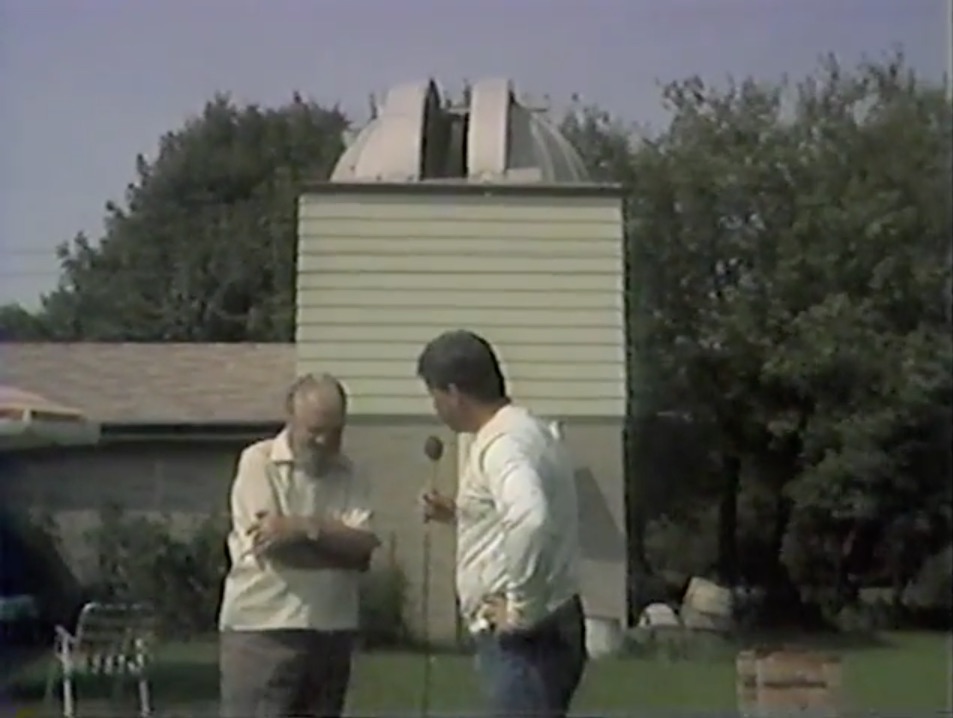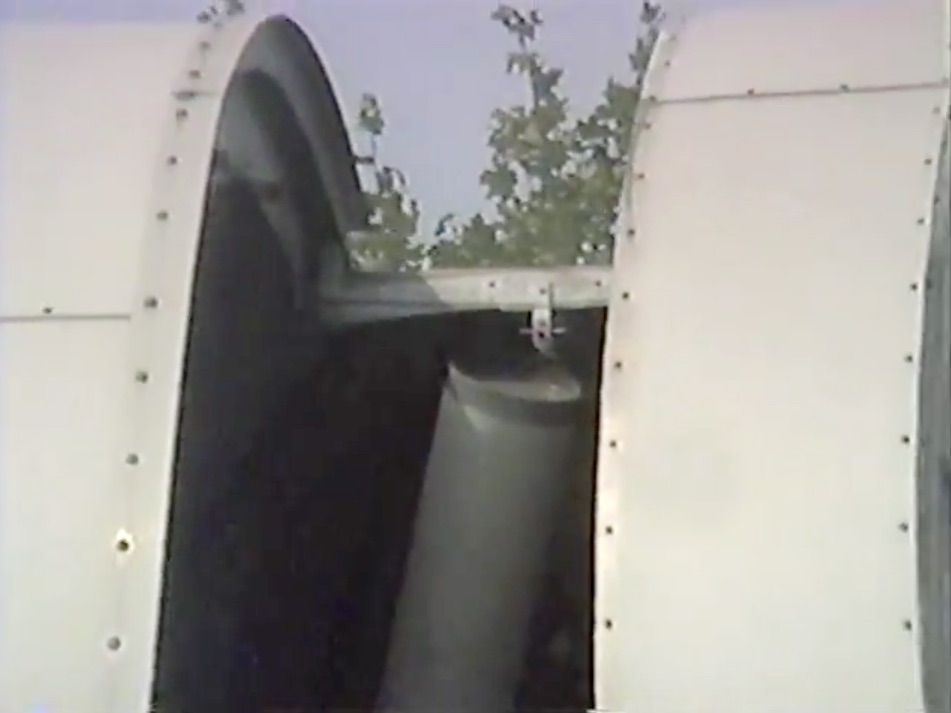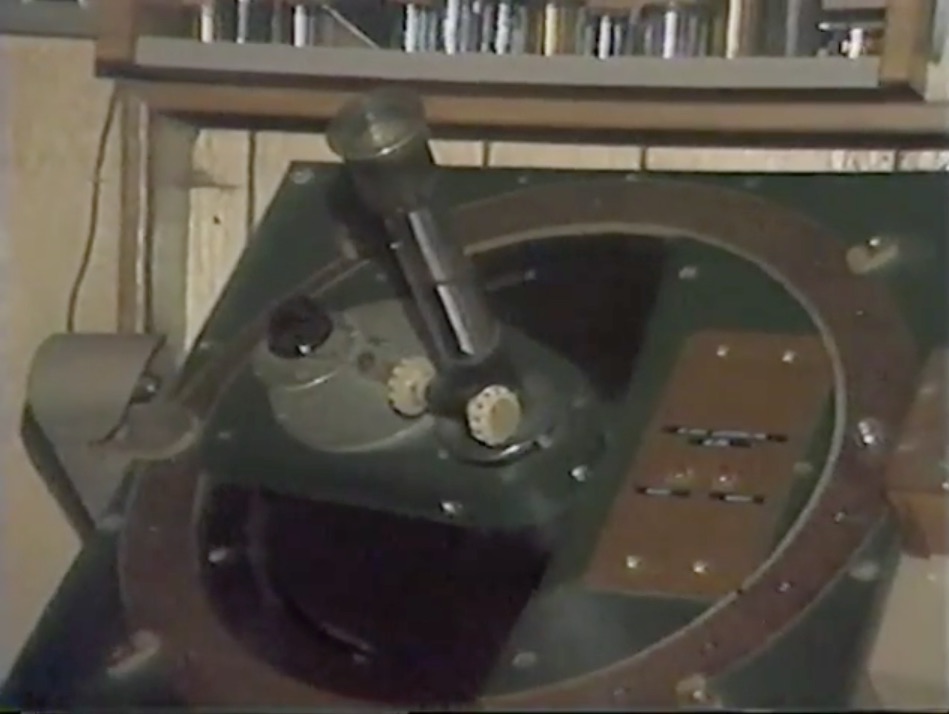(1960–2005) Ray Thompson's observatory at 7 Welton Street, Maple, Ontario.
In 1960, the Maple Observatory in Maple, Ontario was hand built by Mr. Raymond R. Thompson, another very dedicated amateur astronomer. Men of the calibre of Topham and Thompson have contributed much to the science of astronomy. For years Maple Observatory housed a 4-inch f/15 refractor as the main instrument. Later a 4-inch f/10 Gerrish polar axis telescope was added. Those who have not observed through such an instrument, especially in comfort during bitter winter nights, have a wonderful experience in store for them.
Today [1968], the old Maple Observatory has been replaced by a larger observatory attached to Mr. Thompson's house. A 7-inch refracting telescope and a new 6-inch Gerrish telescope have been installed.
Raymond Thompson was awarded the Chant Medal in 1967 and a portion of his contributions to astronomy have embraced lunar and planetary work, novae, comets, variable stars and astrophotography in connection with all these fields. Mr. Thompson has been a member of the A.A.V.S.O. for years and has 5,000 detailed variable star observations to his credit. Thompson, like Topham, shared his knowledge and equipment with others and many have been the groups of starry-eyed youngsters who have been taught to enjoy he visible wonders of the known universe.
—from the centennial edition of 'Scope, 1968
The second generation of this observatory was a Centennial project that took four years to build. It featured a second storey with a 12' silo dome fastened to a custom rolled iron framework, weighed ¾ ton, and was turned by means of a boat winch. Inside the dome was an 8" refractor with a 6" refractor co-mounted. He considered this was an ideal setup for variable star observing which was his main interest.
The most unique feature of this observatory was its Gerrish polar axis telescope. Ray described the telescope (which some in the RASC called the "dial-a-star") this way:
"...this is, you might say, a lazy man's telescope. It operates through the wall and the light is fed through a normal refractor by a flat mirror, and the whole thing is controlled from inside, and that ground floor of the observatory is part of the house, it's heated and you can come out there, open it from inside on a cold night, and do an evening's observing in comfort."
Observing 5–10 variable stars was a good night given the time required to find the star, compare it with the chart, and make the magnitude estimate. Ray claimed not to be a fanatical observer, hence midnight was his bedtime.
By the 1980s light pollution was very bad generally but made even worse by a large rail yard to the south (floodlit all night), and a ball park half a mile to the north (floodlit for night games).¹
The end for Maple Observatory came in December 2005 when Ray moved to Halifax to be near his daughter.² ³

Ray Thompson interviewed by Randy Attwood, 1986.

The 8" refractor just fit in the dome.

The Gerrish polar axis telescope.
1 - Text & pictures adapted from Astronomy Toronto, episode AT45 (Dome, Sweet Dome), 1986
2 - AAVSO PEP Newsletter v24n1 (July 2006)
3 - 'Scope, Feb/Mar 2006
The Telescopes
The opening of the new observatory occurred while I was still active in the RASC. As I recall Ray Broadfoot presided over the ribbon cutting ceremony. Dr. Hogg was unable to be present but she phoned over her congratulations during the festivities, which were attended by a large number of Toronto Centre members. The observatory was our centennial project, started in 1967 and taking 4 years to complete. It consisted of a two-storey addition to our house. The ground floor contained the 4" polar-axis indoor telescope, a drop-head typewriter desk, book shelves, a chart rack, a telephone, sidereal clock, short-wave receivers (and later, two computers). This floor was part of the house and heated. The second storey (unheated) supported the 12' aluminised steel dome which housed twin-mounted 8" and 6" refractors on a massive German equatorial remote-controlled from a console on top of the observing ladder. The 8" was built by RASC member Harold Brown and previously belonged to Terry Dickinson. The 6" and the mounting were of my own fabrication.
The big refractors continued in use until January 1991 when, on returning from our Christmas vacation, we found that the municipality had chosen to fill our subdivision with sodium vapour lights, 20 yards apart and mounted high! The 8", with its 11' long tube was effectively put out of action. I tried canvassing my neighbours with a view to having the lights taken down or shielded. The typical response was, "Light pollution! What's that? I think they’re wonderful. About time we had some decent lights around here." So I was forced to take drastic measures. I dismantled the refractors and replaced them with a 10" Schmidt-Cassegrain. With its stubby tube and the addition of the extra long dew-cap it was easy to shield from the sodium lights and we were once again in business.
Observational Programmes
Regarding the observational programme I followed with this equipment, you probably remember that amateur astronomy was redirected in the seventies by the success of the space probes. There no longer seemed much point in making drawings of lunar and planetary details when thousands of close-up photographs were available. As a result, I confined my activities to areas where earth-bound small telescopes could make some contribution to science, be it ever so humble. My main work during the seventies and eighties was visual photometry of variable stars for the AAVSO [Ray's observer code is THR]. I monitored about 150 stars and for this the twin-mounted refractors were ideal. The 6" f/10 gave a low power, wide field for locating stars and estimating the bright ones, while the 8" f/15 gave a high power view for the faint ones. Before the local sky was drowned by the lights of Toronto, I could reach well beyond 13th magnitude with this telescope. (Photographic photometry became impossible after about 1973.) In addition I timed total lunar occultations. The data for these went to Herstmonceux Castle in the early days and then to the International Lunar Occultation Centre in Tokyo. The third area of activity was the daily sunspot count. This is also organised by the AAVSO. The director of the Solar Division, Peter Taylor, publishes the monthly American Solar Bulletin which gives the American Sunspot Number, based on the data from about 100 observers across the continent. The polar-axis telescope is particularly suited to this. It has a fixed axis and a fixed eyepiece. By using a diagonal and a sunscreen mounted on the console, it is possible, while the drive is running, to trace sunspots on the screen with great accuracy. Afterwards, the use of the Stoneyhurst solar disks provides precise positions for the spots and the exact inclination and curve of the solar equator. Incidentally, this telescope is a boon in the winter since the observer is inside in the warm while the optics are outside in the cold. Its light grasp is less than the dome telescopes and its field of view is limited on the north by the building, but it is still a very useful instrument.
Photoelectric Photometry
In 1978 Doug Welch wrote an article for the Journal on the construction of a photoelectric photometer. Knowing that the AAVSO had recently set up a photoelectric section, I decided to branch out by building a PEP. I worked on this project sporadically for many years. PEPs are notoriously tricky things to get working properly and I had to re-work it several times before I was satisfied. Finally, in the late eighties, I sent some data to Howard Landis, the PEP chairman, only to be told that they were useless! The AAVSO will not accept data taken from a meter: they must be either digital or strip-chart. Not being able to face rebuilding it again and having a little extra cash to spare, I got on the phone and ordered an Optec SSP-3 solid state photometer.
Though I only started at the beginning of 1990, photoelectric photometry has turned out to be the most rewarding and fascinating work I have ever done in astronomy. I still do 'visuals' as well as occultations and the sunspot count, but now PEP has top priority. To date, 420 of my photoelectric measurements have been accepted and last year I was in second place on the list of PEP observers. (Unfortunately there are only 20 of us regularly contributing to the AAVSO.) At the same time I commenced work on John Percy's SARV project (Small Amplitude Red Variables). This is a campaign, initiated by John to verify the variability or otherwise of about 300 M type giants in the Yale Bright Star Catalogue, some of which are listed as "suspected variables." In the last issue of the Photoelectric Photometry Newsletter he reported that for two of my SARVs, HR6543 and HR6815, my data does confirm their variability and gives provisional amplitudes and periods.
The 10" SCT proved to be a superb instrument for PEP, giving standard errors far better than even the 8" refractor, so that I don't regret the change.
In 1985 the Maple Observatory entered the computer age, first with a Commodore 64 and later with an IBM XT. Until I tried it, I had no idea how useful computers could be in an observatory. As an example, I used to use the old transit telescope to check the sidereal clock, but it became redundant when I could call up sidereal time whenever I needed it in a matter of seconds. Then the SSP-3 is designed to be coupled to a computer, and this I managed successfully. The computer takes the raw output of the photometer, integrates it for a selected time, calculates the average of the three integrations, gives the standard deviation of these which immediately shows up drive errors, interloping satellites or aeroplane lights, gives the exact time of the central integration, and displays all this on the screen for each measure. This can then be validated or cancelled if there is something wrong. All the observer has to do is manipulate the telescope and flip the mirror. At the end of the run, the programme does a reduction of the 18 required measurements, including conversion to the UBV standard delta V magnitude and a complete statistical analysis.
Both computers are equipped with modems. Through the help of my friend Stefan Mochnacki at the DDO I was able to join INTERNET so that now all data is transmitted by e-mail, except that ILOC do not yet have a direct connection; data is sent twice yearly on 5¼-inch floppies. The AAVSO recently produced PC compatible software for reporting both the monthly visual estimates and the raw data of the PEP observations. The visuals go directly via Internet to the HQ computers in Cambridge. By the way, my grand total of visuals at present is just under 10,000. The PEP data goes first to Howard Landis in Georgia, who verifies that it is acceptable and forwards it to HQ. His standards are very high: if the mean error is very far from .01 it is likely to be rejected. He is fond of saying that the data is archived for the use of the professionals and he likes to keep it "pure." The solar reports go down on the last day of the month via Internet to Peter Taylor, also in Georgia.
All this keeps me very busy. In 1991 I logged 126 night-time sessions for a total of 465 observing hours. If you add to this 206 separate sunspot counts at about 30 minutes each, my observing total for last year was 332 sessions at 568 hours. You could even say that I have in no way dishonoured the Chant Medal.
—Excerpt of letter from Ray Thompson to Peter Broughton, 1992 March 15
(RASC Archives, People Files, p. 24-26).
